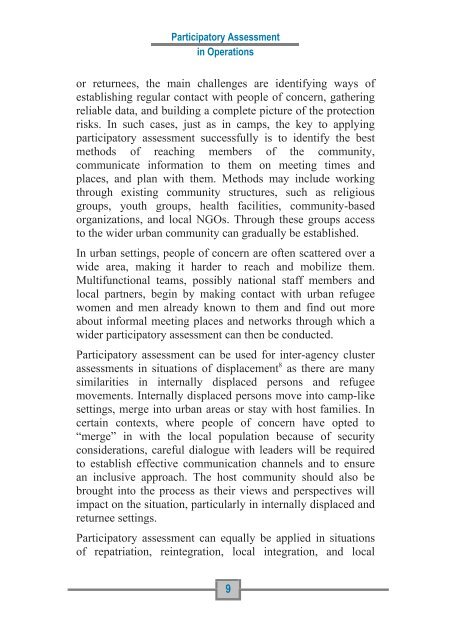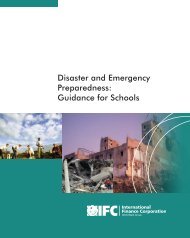Participatory Assessment - Refworld
Participatory Assessment - Refworld
Participatory Assessment - Refworld
- No tags were found...
Create successful ePaper yourself
Turn your PDF publications into a flip-book with our unique Google optimized e-Paper software.
in Operationsor returnees, the main challenges are identifying ways ofestablishing regular contact with people of concern, gatheringreliable data, and building a complete picture of the protectionrisks. In such cases, just as in camps, the key to applyingparticipatory assessment successfully is to identify the bestmethods of reaching members of the community,communicate information to them on meeting times andplaces, and plan with them. Methods may include workingthrough existing community structures, such as religiousgroups, youth groups, health facilities, community-basedorganizations, and local NGOs. Through these groups accessto the wider urban community can gradually be established.In urban settings, people of concern are often scattered over awide area, making it harder to reach and mobilize them.Multifunctional teams, possibly national staff members andlocal partners, begin by making contact with urban refugeewomen and men already known to them and find out moreabout informal meeting places and networks through which awider participatory assessment can then be conducted.<strong>Participatory</strong> assessment can be used for inter-agency clusterassessments in situations of displacement 8 as there are manysimilarities in internally displaced persons and refugeemovements. Internally displaced persons move into camp-likesettings, merge into urban areas or stay with host families. Incertain contexts, where people of concern have opted to“merge” in with the local population because of securityconsiderations, careful dialogue with leaders will be requiredto establish effective communication channels and to ensurean inclusive approach. The host community should also bebrought into the process as their views and perspectives willimpact on the situation, particularly in internally displaced andreturnee settings.<strong>Participatory</strong> assessment can equally be applied in situationsof repatriation, reintegration, local integration, and local
















